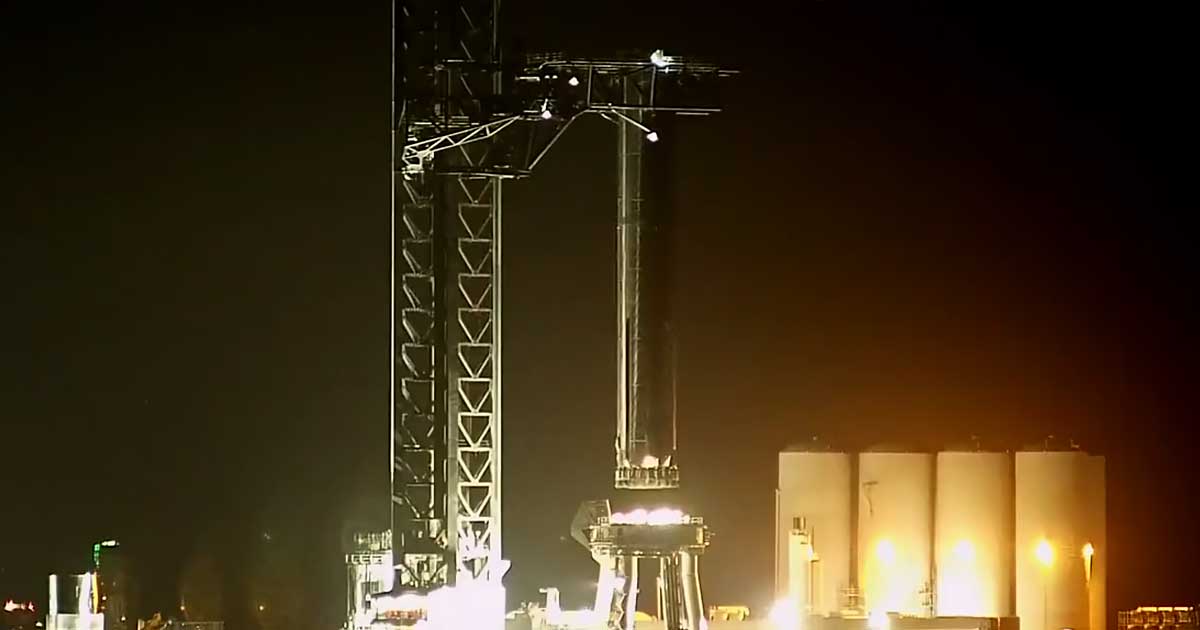


In a major achievement for Elon Musk's company, SpaceX successfully caught the first stage booster of its Starship rocket system using giant robotic arms. Starship, which is designed to revolutionize space travel, is the tallest rocket ever built at 120m. During Sunday's test launch, the booster was caught by the robotic arms named "Mechazilla" on its descent, while the Starship spacecraft continued its journey to orbit before landing in the Indian Ocean.
SpaceX Achieves Landmark Milestone: Starship Booster Caught by Robotic Arms
Elon Musk's SpaceX has taken a major step towards revolutionizing space travel with the successful retrieval of the first stage booster of its Starship rocket system. This achievement marks a significant milestone in the development of the highly ambitious Starship, the tallest rocket ever built at 120 meters.
Background
SpaceX has been working on the Starship system for several years, with the goal of creating a fully reusable spacecraft capable of carrying both cargo and humans to destinations beyond Earth's atmosphere. The first stage booster, weighing over 300 tons, is responsible for lifting the Starship spacecraft to an altitude of about 65 kilometers before returning to Earth for a soft landing.
Test Launch and Catch
On Sunday, February 5, SpaceX conducted a test launch of the Starship system from its facility in Texas. The booster successfully separated from the Starship spacecraft and began its descent back to Earth. As the booster fell through the atmosphere, it was caught by giant robotic arms known as "Mechazilla" mounted on SpaceX's purpose-built landing platform.
The Starship spacecraft, meanwhile, continued its journey to orbit before performing a controlled landing in the Indian Ocean. This marked the first time a reusable booster rocket had been successfully caught after a flight to orbit.
Significance
The successful catch of the Starship booster has major implications for the cost and feasibility of future space missions. By being able to reuse the first stage booster, SpaceX can significantly reduce the cost of launching payloads into orbit, making space exploration more accessible.
Furthermore, the Starship system is designed to be fully reusable, including the spacecraft itself. This means that SpaceX could potentially launch and land multiple Starships on a single mission, further reducing costs and enabling more ambitious space missions.
FAQs
1. What is the purpose of the Starship system?
The Starship system is designed to be a fully reusable spacecraft capable of carrying both cargo and humans to destinations beyond Earth's atmosphere. It is intended to be used for missions to the Moon, Mars, and other planets.
2. How does the Starship booster work?
The Starship booster is responsible for lifting the Starship spacecraft to an altitude of about 65 kilometers. It is powered by 33 Raptor engines and burns liquid methane and liquid oxygen propellants.
3. What are the capabilities of the Starship spacecraft?
The Starship spacecraft is designed to carry up to 100 tons of payload to orbit. It is also equipped with a large living space for astronauts on long-duration missions.
4. When will the Starship be operational?
SpaceX plans to conduct further test flights of the Starship system in the coming months and aims to make the spacecraft operational by 2024.
5. What are the potential applications of the Starship system?
The Starship system has a wide range of potential applications, including carrying cargo and humans to the Moon and Mars, deploying satellites into orbit, and even interplanetary travel.

Tecno has released a new addition to their Spark series in India, the Spark Go 5G, which boasts a 6000mAh battery and a unique camera setup. At a price of under Rs 10,000, it is claimed to be the thinnest in its price segment. Available in four colors and a single storage variant, the phone will be available for purchase from various online and offline stores starting July 21.

On Friday morning, the online ticket booking portal of Indian Railway Catering and Tourism Corporation (IRCTC) crashed, leaving thousands of users unable to complete their bookings for the upcoming Diwali and Chhath Puja holidays. The outage, believed to be caused by an overwhelming number of Tatkal booking requests, spiked sharply around 10 am and continued for several hours. Frustrated users flooded social media with complaints and memes, urging the IRCTC to improve its technology to handle peak traffic during festive seasons.

After years of offering free storage for its popular Memories feature, Snapchat has announced that users will now have to pay for storage if they exceed the 5GB limit. This has caused backlash and frustration among loyal Snapchatters, who feel that they are being taken advantage of and that the sudden change is unfair. Experts believe that this move signals a trend of social media platforms charging for storage as users accumulate more content over time.

A recent YouTube video has given a sneak peek into Samsung's upcoming Galaxy S26 Ultra and its possible specifications. The phone is expected to feature Qualcomm's new Snapdragon 8 Elite Gen 5 chip, making it highly capable for heavy app usage, multitasking, and gaming. Along with improved display and privacy features in One UI 8.5, the phone is rumored to come with a quad-camera setup and a larger battery with faster charging capabilities. Samsung fans may have a lot to look forward to if these leaks turn out to be true.

As anticipation for Samsung's upcoming flagship phone lineup-the Galaxy S26 Ultra builds, rumors and leaks about its features and design have started circulating. With the reported return of the Plus model, the lineup is expected to consist of four models, with the Ultra being the most buzzed-about one. The Ultra may see upgrades in its battery capacity, fast charging capabilities, and processor, while also possibly featuring a new pill-shaped camera island. However, these details are not officially confirmed, and the device is expected to debut in January 2026, according to reports.

YouTube, the Google-owned video streaming platform, suffered a significant global outage, leaving millions of affected users unable to access content for over an hour. The disruption affected not only the main platform, but also related services like YouTube Music and YouTube TV. As users took to social media to confirm the disruption, some pointed out the irony of still receiving ads while videos were not playing. A spokesperson for YouTube reassured users and acknowledged the issue, promising updates as it was being resolved.

Google is getting ready to make a major impact on the creative landscape with the release of VEO 3.1. It has been widely speculated that this update will bring longer clips and improved audio-visual quality for creators through the Gemini app and Vertex AI. Evidence of the release is mounting, with a disclaimer appearing in Gemini and mentions of VEO 3.0 preview models on Vertex AI. Google's staged rollout strategy indicates that they are looking to gather feedback and maximize adoption, solidifying their position in the world of generative media. Keep an eye out for more updates as the release date approaches.

Subscribers of Jio Hotstar were left frustrated and disappointed when they were unable to access the popular app due to a sudden technical glitch. The platform, known for its live events and ongoing shows, acknowledged the issue and apologized for the inconvenience caused to its users. Despite receiving numerous complaints on X and other social networks, Jio Hotstar's technical team has confirmed that the problem has been fixed. The platform has also reminded users to refrain from making offensive comments, stating that such behavior is punishable by law.

Twitter's head of product, Nikita Bier, announced a new feature that will display a user's country on their profile page. The update is aimed at enhancing authenticity and verifying information on the platform. However, with many India-based accounts known for spreading disinformation, the feature has sparked controversy and raised concerns about privacy. Twitter plans to implement privacy toggles, but users who opt out may be highlighted on their profile page, leading to potential backlash and further discussion on the role of social media in spreading false information.

India successfully test-fires its next-generation Agni-Prime missile from a rail-based mobile launcher, adding a new dimension to its strategic deterrence capabilities. The advanced rail-based system allows for greater mobility and flexibility in launch locations, increasing survivability during combat. Experts say this gives India a powerful advantage, especially in light of evolving security threats and past attacks on traditional military bases.